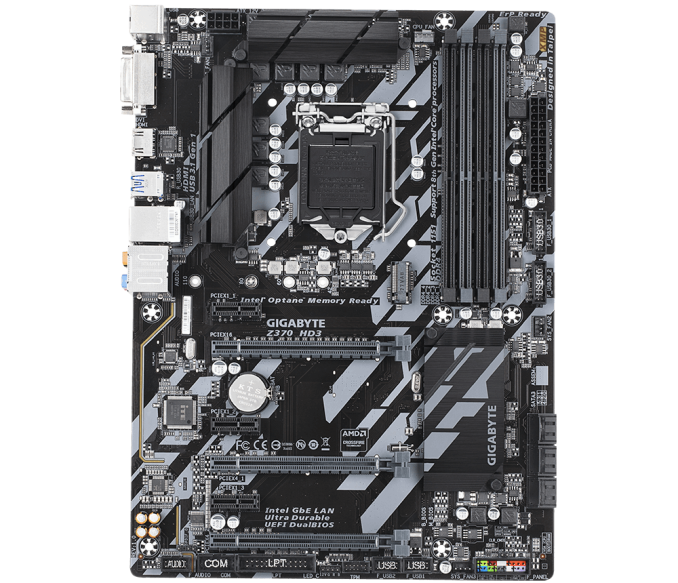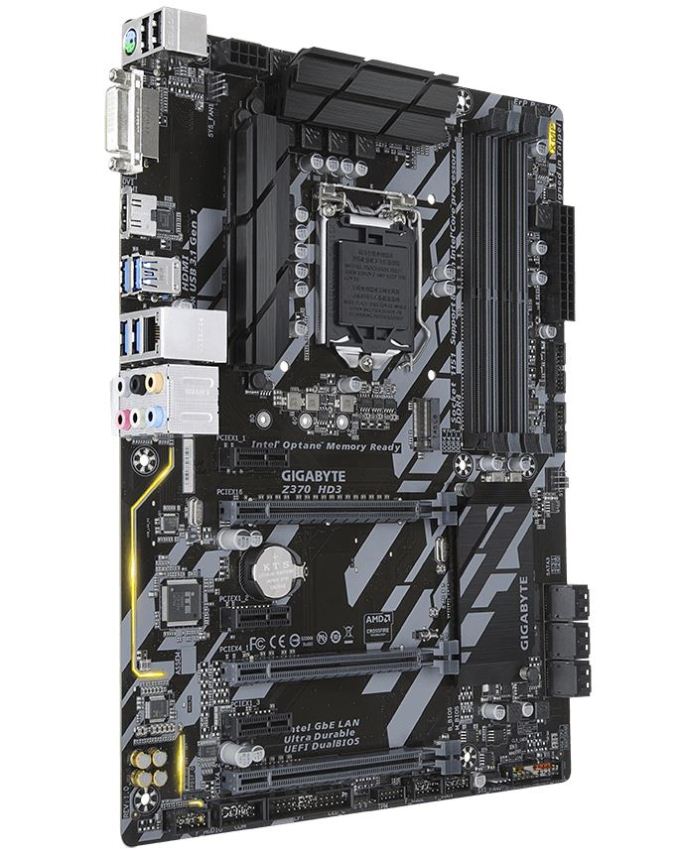Analyzing Z370 for Intel's 8th Generation Coffee Lake: A Quick Look at 50+ Motherboards
by Ian Cutress, Anton Shilov, Joe Shields & Gavin Bonshor on October 20, 2017 2:00 PM ESTGIGABYTE Z370 HD3
The last of the nine GIGABYTE boards for this article is the entry-level Z370 HD3. The HD3 slides in below the HD3P, and despite the minor name difference, has a more different layout than expected. The HD3 is a board for the budget conscious looking to get into the platform at the lowest entry point. For example, the HD3 does not have USB 3.1 (10 Gbps) ports on the board, has only one M.2 slot instead of two or three, and doesn't have slot reinforcement on any PCIe or DIMM slot.
The HD3's appearance is nearly a carbon copy of the HD3P, except the grey stenciling is on the board and chipset heatsink only, and is not on the VRM heatsinks. The memory slots are the same two black and two gray, while all PCIe slots (none with reinforcement) are grey with the PCIe x1 slots in black. The PCH heatsink is also carried over. The only non-standard LEDs on the board is the audio separation line and the XMP notification in the top right-hand corner.
Users still receive the full complement of four memory slots supporting up to 64GB in capacity, while GIGABYTE states a maximum supported speed of up to DDR4-4000. For PCIe, the two full-length slots are wired to run in an x16/x4 configuration driven by the CPU with the third also running at x4 speeds but fed from the chipset. That said, there is only support for 2-Way AMD Crossfire or AMD Quad-GPU Crossfire (2x dual GPU cards) as SLI requires x8 per slot minimum.
As mentioned earlier, the HD3 is down to one M.2 slot, the least on any of the Gigabyte boards. For most users that might be of little concern as they only have one M.2 based drive. The board contains six SATA ports supporting RAID 0, 1, 5, and 10, rounding out storage connectivity. There are a total of four fan headers on the board, with one to the right of the VRM heatsink on top, another close to the EPS 12V connector, while the other two system fans are at the bottom of the board and on the middle right side just above the SATA ports. The included Smart Fan 5 application is still able to control the hybrid PWM/Voltage controlled headers. The audio codec on the HD3 steps down to the ALC892 codec. It also does not have EMI shielding but the board design still separates the boards analog audio components from the digital components on the PCB. For networking, one of Intel's GbE LAN chips covers the network side for the HD3.
The USB side of the house is going to be fairly straightforward. From the chipset, the board has eight USB 3.1 (5 Gbps) ports with four on the back panel and for more available through internal USB headers. Users will also find six more USB 2.0 ports with two on the back panel, and four more available through internal USB headers. There are no USB 3.1 (10 Gbps) ports on this board, allowing for cost savings, although users can still purchase USB 3.1 (10 Gbps) PCIe cards to expand functionality if needed. The back panel IO also includes a combination PS/2 port, a DVI-D video output, a HDMI video output, and the audio jacks.













83 Comments
View All Comments
carldon - Saturday, October 21, 2017 - link
Excellent summary and table in the last page. Good work!!!imaheadcase - Saturday, October 21, 2017 - link
I got a few questions:1. Why do they put USB 2.0 ports if USB 3.0 is backward compatible anyways? Why not just all USB 3.0 ports..it can't be price.
2. Why do they have such a vary in memory timings? For %99 of people memory timings are not really a big deal right? Maybe in old PC days it was.
3. Mini-ITX vs Micro-ITX..isn't it silly both exist in first place? Any reason for this..the diminsions are really close to the same. In fact, most Micro-ITX is simply removing lots of stuff from mobo that you really want to begin with.
lordsutch - Saturday, October 21, 2017 - link
I'd imagine they want to offer as many ports as they can without taking away too many PCIe lanes. The other option would be to embed a USB 3.x switch (or a PCIe switch) but of course now each port wouldn't simultaneously be able to operate at peak speed and 3.x switches are probably more expensive than USB 2 controllers.imaheadcase - Sunday, October 22, 2017 - link
Ahh didn't think about that aspect.DanNeely - Saturday, October 21, 2017 - link
Some USB audio and 2.4ghz wifi/bluetooth devices have had interference problems in 3.0 sockets. Dunno if they're fixed on new hardware (supposedly onboard hubs were a lot worse than chipset ports in this regard so room for QC to make it better); but even if they are there's going to be problems with once burned customers not trusting them.As pointed out elsewhere USB3 competes with PCIe lanes/SATA ports on the southbridge. Especially on full ATX boards if you go to max out the number of PCIe lanes to expansion slots and m.2 ports in addition to the lanes used on board for networking and audio you can get down to only a half dozen or so 3.0 lanes left from the chipset; but still able to hit 14 USB ports total by going USB2 with the rest.
People using older OSes (Windows 7 says hi) can't use USB3 ports to install the OS without jumping through a lot of hoops (the OS sees them as not USB2 and can't talk to them).
If any board size is at risk of going away it's probably full ATX; although for enthusiast sales I suspect it'll hold on better than mini ATX due to bigger is better irrationality.
MiniITX still has a decent capability gap vs mini ATX; but it's much smaller than it was a half dozen years ago when it only made sense if you were making a tiny box and were willing to accept major performance compromises to do so. Now as Mini ITX's capability continues to goes up and the need for expansion cards other than a single GPU goes down it's eating into an increasing chunk of Mini ATX's marketshare.
On the high side mainstream chips don't really have enough PCIe lanes to make good use of the extra 3 cards of space possible on the bigger boards/ Meanwhile multi-GPU gaming - the main reason an enthusiast would need a full size mobo is steadily going away (fewer games supporting it each year, no support for 3/4way at all in the newest cards from either company); and unless you need 2 GPUs + something else or extra space around the CPU for crazy OCing Mini ATX does almost everything that could be needed.
MadAd - Sunday, October 22, 2017 - link
> If any board size is at risk of going away it's probably full ATX; although for enthusiast sales I suspect it'll hold on better than mini ATX due to bigger is better irrationality.Irrationality indeed. I would have thought by now instead of a measly 5 mATX choices out of 50+ that it would be instead maybe 5 fullsize ATX with the main battleground being the two slot mATX market.
Its just laziness on the manufacturers side, with nobody steering the market to innovate on size. Theres nobody driving form factors, the CPU companies are present on all form factors so they dont need to drive change, the board partners are all set in their ways just slapping new images on mildly reworked designs so they dont have any need to innovate, weve seen video card manufacturers can shrink designs to better fit smaller factors but we still get chunky easy to produce cards for mainstream use as retooling would be an added cost, its just rolling train of new but nothing new generation after generation.
PC design is falling into mediocrity and I just wish the main players (intel+amd/board partners/nvidia+amd) would all get together to drive SFX/ITX and force retire ATX to the strictly enthusiast market, and maybe appeal to a more contemporary home user community (rather than just gamers which is where the marketing all seems to be these days) again too.
Liltorp - Saturday, October 21, 2017 - link
It is really true that the MSI PC Pro has a legacy PCI connector? I could use this for my TV tuner. But I thought PCI was not supported by newer boatds/CPU`s?Morawka - Saturday, October 21, 2017 - link
Has anyone noticed how cheap these new Z370 motherboards are? Most are under $180 and there are several sub $130.IGTrading - Sunday, October 22, 2017 - link
Tell this to the guys that already spent money on non-Z370 just a few months ago.Intel is already screwing them.
It would have been funny to sell a 250 USD motherboard to a 7700K buyer just last month, telling him his 250 USD are a good investment because of the good upgradeability.
Just 4 weeks later tell him: "Well ... Yeah ... About that upgrade ... It will cost you a minimum of 110 USD extra + the 360 USD for the new 8700 K.
775 was the last good & long lived platform from Intel.
edzieba - Sunday, October 22, 2017 - link
If people brought Z370 boards expecting them to support an additional CPU generation, they did it in spite of every Intel CPU release for the last decade: two CPU gens socket generation. There's no counter to ignoring the past.